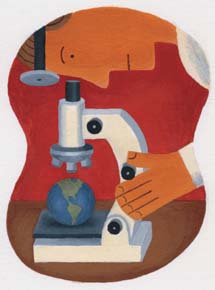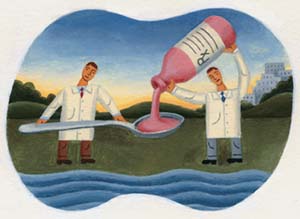 |
 |
| current issue |  |
past issues |  |
send a letter/news |  |
address update |  |
advertise |  |
about us |  |
alumni home |
Illustrations by James Kaczman
In this issue:
What's in a Name?Bird Brain
Just Add Water
What's in a Name?
Sponsoring a stadium may not be a sign of hubrisby Jill Sullivan Grueter '99

|
What happens when a global giant makes a mega-million-dollar deal to purchase the right to name a sports stadium? Does the decision foreshadow the demise of the company? Enron, for example, bought the right to name the home of the Houston Astros two years before declaring bankruptcy.
UNH associate professor of finance Stephen Ciccone and several other educators around the country conducted a study to test the theory that purchasing naming rights is financially harmful to a company.
"Basically, these deals are very unpopular with the fans," says Ciccone, noting that in an ESPN poll, naming rights were on the top 10 list of worst sports innovations. "Because you are taking, for example, the Boston Garden, with champions like Larry Bird and Kevin McHale, and all of the sudden the stadium is some other name. This isn't popular with the public," he adds. "Companies find that there is a backlash from the fans."
As a result, many members of the financial press have used naming-rights deals as an extreme example of managerial hubris, and companies that later do poorly are said to suffer from the "naming-rights curse," says Ciccone.
So, why are companies today spending nearly $4 billion in the United States in naming- rights deals linked to professional sports teams?
Ciccone and his team found that companies like Enron and Adelphia are the exception rather than the rule. "In our findings, some companies do go bankrupt" after the purchase of a sports complex, says Ciccone. "But we found that these times were record years for companies going under." (The year 2002 set a record for public companies going bankrupt: 186 firms with a total of $368 billion in assets filed for bankruptcy.)
The study looked at publicly traded firms that purchased naming rights from 1990 to 2002. The researchers found that firms buying naming rights usually had impressive financial statistics both before and after the agreement was signed.
"Naming-rights deals are typically done after a period of good performance," says Ciccone. Post-agreement, the sponsoring firms' net income and sales typically did better, and the long-term stock returns--a gain of 17.5 percent over three years--were similar to the control group.
When Rich Foods bought the right to name the new home of the Buffalo Bills football team in 1973 for $1.5 million, it was the first naming-rights agreement in the United States. Now, more than half of all major professional sport arenas and stadiums carry the name of a corporation. "For better or worse," he notes, "there is no question that naming-rights deals are on the increase."
Bird Brain
Satellites can help track the spread of avian fluby David Sims '81
Tracking the movement of a deadly microscopic virus across a country by satellite might seem more like science fiction than solid science. But UNH researchers Xiangming Xiao and Steve Frolking '80, '83G, '93G have been using a remote sensing technique to help the United Nations Food and Agriculture Organization better understand the global ecology of avian influenza.
Using data from the Moderate-resolution Imaging Spectroradiometer aboard NASA's Terra and Aqua satellites, the two scientists are helping pioneer the effort to track the spread of the subtype "H5N1" of the Highly Pathogenic Avian Influenza virus--commonly known as bird flu--which has the potential of causing a worldwide pandemic.
In Thailand, when rice is harvested, a farmer will drive hundreds or even thousands of free-ranging domestic ducks into the harvested fields so they can eat the leftover grain and the insects.

|
These free-ranging ducks, while not falling ill themselves, serve as hosts for the bird flu virus and can infect other domestic poultry, wild migratory birds and humans susceptible to the disease's potentially deadly consequences.
This system of farming using free-ranging ducks is largely concentrated in regions with two or three rice cultivations per year, which provides ducks with food and water throughout the year at low cost. The ducks, in turn, are the main source of protein for the low-income farmers and their families.
Across the globe, agricultural expansion has resulted in substantial losses of natural wetlands, and intensified agricultural practices such as double or triple crops in a year have generated alternative habitats for wild birds.
Flooded paddy fields become part of the habitat of migratory wild birds during winter, and wild birds and free-ranging ducks mixing together increases the likelihood of the virus being spread.
To identify where high-risk regions are and what the high-risk time period is, Xiao and colleagues at Complex Systems Research Center in the UNH Institute for the Study of Earth, Oceans and Space relied on a method they had developed to analyze remote-sensing data and map paddy fields and harvest timing from space. Tracked via remote sensing, the rice harvesting data are entered in a risk assessment model. With the information, public health officials can perform targeted sampling and monitoring of the free-ranging ducks and, theoretically, the spread of the virus.
"With these satellite instruments," says Frolking, "you can get within a week or two of real-time data. So, for example, you get a spatial map that's only lagging by a week as opposed to traditional census data that is lagging by a year or two or three."
Because migration of many wild birds is a temperature-driven phenomenon, scientists can also use satellites to remotely sense land surface temperatures and predict the likelihood of the onset of migration to breeding, molting and wintering grounds. And, unlike weather station or climate data, which is spotty in many poor or remote regions, satellites can provide broad, high-resolution, real-time temperature data.
Says Xiao, "This is all about having geospatial information to do a risk assessment, to help develop the surveillance system and the early warning and early response strategies. We're testing this in the most complex agricultural setting, Asia," he adds, "and if we can do it well there we believe we can do the same in the United States."
Just Add Water
A new all-in-one treatment for polluted river bedsby Dolores Leonard
UNH engineers are designing a "sniffling, sneezing, aching, fever, so-you-can-rest" remedy for polluted river sediment. Jeff Melton '94G and Kevin Gardner are part of a bi-coastal team that received a $1.1 million grant from the Department of Defense to combine different remediation strategies into one "prescription" for sediments contaminated by a range of pollutants.

|
"Sediment often contains a variety of pollutants, but there's no silver bullet to treat all of them," says Melton, a research assistant professor in UNH's Environmental Research Group. "One technology might address heavy metals, while another treats PCBs. We're combining different approaches into a single delivery system to address several pollutants at once." Which, given the condition of sediment in many urban waterways, may be just what the doctor ordered. Years of auto emissions, storm-water runoff and industrial waste have polluted river beds with heavy metals like lead and mercury and toxic organic chemicals.
Dredging out polluted hot spots or capping them with several feet of sand are common responses to this problem, but they have drawbacks. Dredging disrupts habitats, releases pollution into the water and poses the problem of where to put all that toxic sediment. Since sand caps must be thick enough to slow the spread of pollution, they are expensive to maintain, can hinder boat traffic and put a damper on aquatic life.
The researchers are experimenting with a new class of treatments for the sediment remediation toolkit--reactive caps made from absorbent materials that treat pollution, rather than just remove it or cover it up.
"Caps that are made only from sand act like physical barriers to slow the spread of pollution," explains Melton. "Reactive caps, like the ones we're using in this project, bind and stabilize pollutants, effectively removing them as a threat. These caps are much thinner, so they are potentially more cost-effective and may be used where sand caps are not practical."
The team's multi-pollutant remedy consists of activated charcoal, apatite and organoclays all mixed together and spread between two layers of geotextile fabric. The thin, engineered mats will be rolled out over stretches of polluted sediment.
UNH researchers first explored apatite, a natural form of phosphorus that treats heavy metals, and the organoclays--which tackle PCBs--independently, with funding from the Cooperative Institute for Coastal and Estuarine Environmental Technology (CICEET), a partnership of UNH and NOAA.
"This project was a natural evolution of CICEET's technology transfer grant to develop apatite as a practical tool for sediment clean up," says Melton. "What we learned from that work led to using mats as a delivery system. Now we're exploring how different treatments can work together. Ultimately, the goal is to design treatments that address the idiosyncratic profile of pollutants in a given place."
blog comments powered by Disqus

